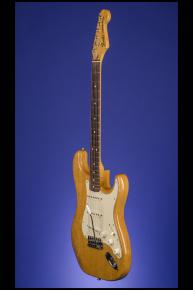'Under The Bed' for Thirty-four Years
1982 Fender Stratocaster "Dan Smith".
This 1982 "Dan Smith" Stratocaster weighs 9.40 lbs. and features a one-piece ash, contoured body with a wonderful natural finish. One-piece maple neck with a nut width of just over 1 5/8 inches, a scale length of 25 1/2 inches and a very fast thin profile (0.78 behind the nut rising to just 0.83 behind the twelfth fret). Veneer rosewood fretboard with 21 original medium frets and pearloid dot position markers. Small headstock with "Fender" logo in black with gold trim, "Serial Number E 212555" in black beneath, "Stratocaster" in black beside it, and "Made in U.S.A." in black beneath. Individual Fender "F" closed-back tuners with octagonal metal buttons. Two "butterfly" string trees with nylon spacers. Four-bolt neck plate with the Fender backward "F" logo. Three white plastic covered Stratocaster 'flat-pole' pickups with outputs of 5.84k, 5.77k, and 7.56k. All with "016730" stamped in relief, the neck and middle pickups with "10182" in yellow marker. Three-layer white over black plastic pickguard with eleven screws. Three controls (one volume, two tone) plus five-way selector switch, all on pickguard. The 250k potentiometers are all stamped "013446 19 8206" (CTS, February 1982). Black plastic ribbed-sided control knobs with gold lettering. Fender "Synchronized Tremolo" combined bridge/tailpiece. The end of the neck is dated "122082" (December 20, 1982). The underside of the neck has a black circular stamp "FRR 20".The neck pocket is stamped in black "12 22 82 (December 22, 1982) and has a black circular stamp "FRR 40". The middle pickup cavity has a yellow circular label with "JM 1/13"? written in black ink. The cavities are painted with black shielding and the control cavity has a small circular label with a circular stamp "FRR 11 11"? This guitar is in near mint (9.25++) condition. The only reason that we do not give it a 9.50 is that there are a few tiny belt-buckle marks on the back (only visible under direct light) and a miniscule amount of fretwear which is commensurate with this guitar having spent most of its life 'under-the-bed' in its case. Most certainly the cleanest and best example we have ever seen. With the original white plastic tipped tremolo arm. Housed in the original Fender 'tweed' hardshell case with tan leather ends and red plush lining (9.25).
The early '80s saw another change in Fender management that brought changes to the Strat design spear-headed by marketing director Dan Smith. In an effort to bring back the design elements from the early years of the model and increase quality, these "Smith Strats" had a smaller headstock and a four-bolt neck. (Reverb.com).
"The Stratocaster was launched during 1954 [and was priced at $249.50, or $229.50 without vibrato]. Samples around May and June were followed by the first proper production run in October. The new Fender guitar was the first solidbody electric with three pickups [Gibson's electric-acoustic ES-5, introduced five years earlier, had been the overall first], meaning a range of fresh tones, and featured a new-design vibrato unit that provided pitch-bending and shimmering chordal effects. The new vibrato -- erroneously called a 'tremolo' by Fender and many others since -- was troublesome in development. But the result was the first self-contained vibrato unit: an adjustable bridge, a tailpiece, and a vibrato system, all in one. It wasn't a simple mechanism for the time, but a reasonably effective one...Fender's new vibrato had six bridge-pieces, one for each string, adjustable for height and length, which meant that the feel of the strings could be personalized and the guitar made more in tune with itself...The Strat came with a radically sleek, solid body, based on the outline of the 1951 Fender Precision Bass. Some musicians had complained to Fender that the sharp edge of the Telecaster's body was uncomfortable...so the Strat's body was contoured for the player's comfort. Also, it was finished in a yellow-to-black sunburst finish. Even the jack socket mounting was new, recessed in a stylish plate on the body face...the Fender Stratocaster looked like no other guitar around [and in some ways seemed to owe more to the contemporary automobile design than traditional guitar forms], especially the flowing, sensual curves of that beautifully proportioned, timeless body. The Stratocaster's new-style pickguard complemented the lines perfectly, and the overall impression was of a guitar where all the components ideally suited one another. The Fender Stratocaster has since become the most popular, the most copied, the most desired, and very probably the most played solid electric guitar ever" (Tony Bacon, 50 Years of Fender, p. 18).














